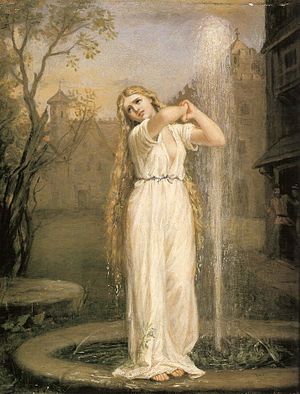Central sleep apnea
| Central sleep apnea | |
|---|---|
| Synonyms | primary alveolar hypoventilation, alveolar hypoventilation secondary to neurologic disease, idiopathic acquired central hypoventilation syndrome |
 |
|
| Ondine by John William Waterhouse (1849–1917) | |
| Classification and external resources | |
| ICD-10 | G47.3 |
| ICD-9-CM | 348.8 |
| OMIM | 209880 |
| DiseasesDB | 32976 |
| MedlinePlus | 000078 |
| eMedicine | article/1002927 |
| MeSH | D020182 |
| GeneReviews | |
Central sleep apnea (CSA) or central sleep apnea syndrome (CSAS) is a sleep-related disorder in which the effort to breathe is diminished or absent, typically for 10 to 30 seconds either intermittently or in cycles, and is usually associated with a reduction in blood oxygen saturation. CSA is usually due to an instability in the body's feedback mechanisms that control respiration. Central sleep apnea can also be an indicator of Arnold–Chiari malformation.
Individuals without sleep apnea are sleeping while "at rest" as far as cardiovascular workload is concerned. Breathing is regular in a healthy person during sleep, and oxygen levels and carbon dioxide levels in the bloodstream stay fairly constant: After exhalation, the blood level of oxygen decreases and that of carbon dioxide increases. Exchange of gases with a lungful of fresh air is necessary to replenish oxygen and rid the bloodstream of built-up carbon dioxide. Oxygen and carbon dioxide receptors in the blood stream (called chemoreceptors) send nerve impulses to the brain, which then signals for reflexive opening of the larynx (enlarging the opening between the vocal cords) and movements of the rib cage muscles and diaphragm. These muscles expand the thorax (chest cavity) so that a partial vacuum is made within the lungs and air rushes in to fill it. In the absence of central apnea, any sudden drop in oxygen or excess of carbon dioxide, even if small, strongly stimulates the brain's respiratory centers to breathe; the respiratory drive is so strong that even conscious efforts to hold one's breath do not overcome it.
In pure central sleep apnea, the brain's respiratory control centers, located in the region of the human brain known as the pre-Botzinger complex, are imbalanced during sleep and fail to give the signal to inhale, causing the individual to miss one or more cycles of breathing. The neurological feedback mechanism that monitors blood levels of carbon dioxide and in turn stimulates respiration fails to react quickly enough to maintain an even respiratory rate, allowing the entire respiratory system to cycle between apnea and hyperpnea, even for a brief time following an awakening during a breathing pause. The sleeper stops breathing for up to two minutes and then starts again. There is no effort made to breathe during the pause in breathing: there are no chest movements and no muscular struggling, although when awakening occurs in the middle of a pause, the inability to immediately operate the breathing muscles often results in cognitive struggle accompanied by a feeling of panic exacerbated by the feeling associated with excessive blood CO2 levels. Even in severe cases of central sleep apnea, however, the effects almost always result in pauses that make breathing irregular rather than cause the total cessation of breathing over the medium term. After the episode of apnea, breathing may be faster and/or more intense (hyperpnea) for a period of time, a compensatory mechanism to blow off retained waste gases, absorb more oxygen, and, when voluntary, enable a return to normal instinctive breathing patterns by restoring oxygen to the breathing muscles themselves.
...
Wikipedia
